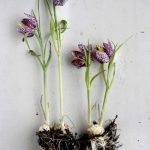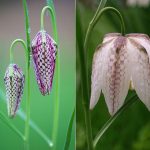A particularly beautiful plant transforms the meadows into a sea of dark red flowers in spring. This is namely the protected chess flower with the scientific name Fritillaria meleagris L. – a species of lily that is rarely found in Europe. Also known as the checkerboard flower or lapwing egg, this early bloomer stands out due to the unique checkered pattern of its flowers. From deep purple to light brown-pink, the spring-like magical flower creates a special eye-catcher in the garden in many different shades. If you would like to bring the beauty of the checkerboard flower into your garden, you will find out which varieties there are and how they can be planted and propagated.
a very special early bloomer with patterned flowers like a chessboard
Heyday the chess flowers
The chess flower is a perennial bulb plant, the flowering period of which lasts from mid-April to the beginning of May, whereby the individual flowers only last about five days. From the small bulbs of this type of lily a shoot grows in spring, which develops into a 15 to 30 centimeter high stem with 4-6 pointed leaves and a bell-shaped hanging flower. The characteristic purple-white spotted pattern of individual petals looks like a chessboard on closer inspection.
Because you can only rarely find this special flower and in very specific locations it is one of the protected species in Germany and is even on the red list. But some varieties of checkerboard flowers have proven themselves especially for the garden and you can find them in stores.
the attractive chess flower as a houseplant and magic flower in the garden
Which varieties of checkerboard are there?
The varieties of the attractively patterned chess flower differ in their flower color.
Red checkerboard flowers:
- ′ Saturnus′: Red-purple flower with a distinct checkerboard pattern
- ‘Mars’: deep red to purple flowers; blue-green leaf
- ‘Charon’: dark red to deep purple, almost black flower with a light purple checkerboard pattern
White checkerboard flowers:
- ′ Alba ′: white flower with a recognizable checkerboard pattern
- ‘Aphrodite’: white flower with a delicately recognizable checkerboard pattern and green lines
- ′ Pomona ′: White with light purple; green lines
the bell-shaped hanging flower of this type of lily appears in different shades of color
 © DB Nature Photography / © Kate Murden
© DB Nature Photography / © Kate MurdenThe following are available in stores:
- ‘Aphrodite’
- ‘Charon’
- ‘Artemis’: purple-green with a diced pattern
- ‘Emperor’: purple-gray, checkered
- ‘Poseidon’: diced a little lighter and purple-pink
- “Saturnus”: checkerboard pattern in light and dark red
Chess flowers do best in moist soil in a sunny to partially shaded location
Planting and location
It is best to plant the chess flower on the edge of water or wood, because it feels most comfortable in moist soil in a sunny to partially shaded location. If it is adequately supplied with water, it can also thrive in planters and even in the apartment. A low-nutrient and peat-free potting soil is suitable for this.
To find out about Easter the beauty of this early bloomer To be happy in the garden, you have to plant the hazelnut-sized bulbs of the checkerboard flower in the ground from August to November at the latest. The onions should be placed at a depth of 5 to 10 cm and at a distance of 15-20 cm. To protect the onions from rot, you can put them on a thin layer of sand, as this allows the water to drain off better. After planting, the soil must be kept constantly moist and, if there is severe frost in the first year, a light winter cover is recommended.
The checkerboard flower can also be planted in a planter and can even be kept indoors
Care tips:
- The chess flower needs regular watering. Even as a houseplant, it should always be kept moist.
- If kept in the living room, the flower must not be exposed to warm air from the heating system.
- A small amount of fertilizer is useful in spring, although ready-made compost can also be used as fertilizer in the garden
- Do not cut off the wilting parts of the plant immediately, because the onion gains valuable nutrients from them and thus creates energy reserves for budding in the following year. Therefore, do not remove the withering leaves until the foliage has completely yellowed.
With its chessboard-like spots, this early bloomer also attracts bees
Hibernate and multiply
This unique bulb flower is hardy and perennial. Your bulbs can simply overwinter in the flowerbed and, under the right conditions, the checkerboard flower will even reproduce itself from year to year.
In principle, the checkerboard flower can be propagated in two ways – either by seeds or by dividing the onions. In the second case, carefully separate the bulbs that have formed on the side from the main onions. This can be done after the plants have wilted completely. After singulation, the young bulbs should be replanted immediately.
Leave a reply




















